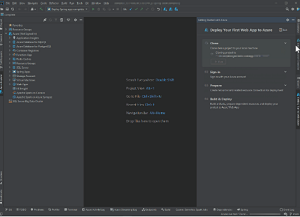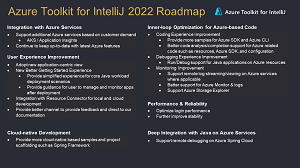News
Azure Java Tooling Has New IntelliJ 'Getting Started' Experience
A new "getting started" experience for Java on Azure dev tooling promises to have IntelliJ jockeys up and running with their first deployment within a few minutes.
Microsoft's dev team for the Azure Toolkit for IntelliJ, available in the JetBrains Marketplace, announced the new experience in a July 5 blog post.
The toolkit helps Java developers develop, configure, test and deploy highly available and scalable Java web apps. Also, it can help Azure Synapse data engineers, Azure HDInsight developers and Apache Spark on SQL Server users in the creation, testing and submitting of Apache Spark/Hadoop jobs to Azure from IntelliJ on all supported platforms. It works with all three editions of IntelliJ IDEA (Ultimate, Community and Educational).
Microsoft has invested its own developers and resources in maintaining the tool for use with JetBrains' IDE, even though the company's own Visual Studio Code editor (which acts like a full-fledged IDE through various extensions) is often used for Java development in the Azure cloud.
Now, Microsoft is hoping its competitor's tool is easier to use for beginners.
"We realize that the getting started experience is critical for developers who just start to learn about Azure," the team had said earlier in forecasting the new experience. "Therefore, we plan to make investments to redefine and improve our getting started experience, which includes simplifying the experience for core Java workload deployment scenarios, providing guidance for user to manage apps and monitoring apps after deployment."
In this week's update announcement for July 2022, the team listed several challenges faced by developers new to Azure:
- Deep learning curve: Developer needs to go through unfamiliar, Azure-specific concepts and other tools as beginners
- Scattered documentation: Documentation could be hard to find and contains too many number of steps
- Lack of guidance: No step-by-step guide to guide users from start to finish
Now, the new getting started experience has arrived to address those challenges. It's accessible in three different ways: by a toolbar click in Azure Explorer, a right-click on the Azure node or via the Tools menu.
"With this new getting experience, you will be able to finish your first deployment to Azure within several minutes, even if you have no experience," said program manager Jialuo Gan. "During this process, you will get familiar with Azure Toolkit features and Azure concepts for boosting your productivity as a Java developer on Azure. After you have upgraded or installed the latest of the toolkit, it will automatically open the getting started experience on the right side for the first time."
Upon opening, the experience gives developers the option to get started by deploying their first web app to Azure or a function app (for Azure Functions serverless computing). After that, the plugin takes over, guiding the developer through the entire process of cloning signing in, preparing and finally building & deploying.
The animated GIF below illustrates the process.
 [Click on image for larger, animated GIF view.] Getting Started with Azure Toolkit for IntelliJ 2022 in Animated Action (source: Microsoft).
[Click on image for larger, animated GIF view.] Getting Started with Azure Toolkit for IntelliJ 2022 in Animated Action (source: Microsoft).
As shown below in the tool's 2022 roadmap, the new and better getting started experience is one of Microsoft's goals to improve the user experience.
 [Click on image for larger view.] Azure Toolkit for IntelliJ 2022 Roadmap (source: Microsoft).
[Click on image for larger view.] Azure Toolkit for IntelliJ 2022 Roadmap (source: Microsoft).
The team also added support for Managed Identity Authentication, which is now available on the Maven Plugin and Gradle Plugin. Managed identities eliminate the need for developers to manage credentials needed to secure communications between Azure services.
Gan also announced EAP and snapshot version support. "Azure Toolkit for IntelliJ has supported the IntelliJ 2022.2 EAP version," he said. "Besides, the latest release of the Azure Toolkit for IntelliJ also brings support for snapshot and beta versions. Now, if you want to try some new features that haven't been released, you can download and install the newest version from the marketplace page."
About the Author
David Ramel is an editor and writer at Converge 360.